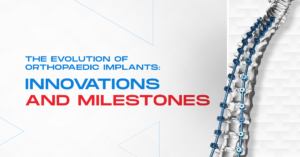Orthopaedic implants have undergone a remarkable evolution over the past several decades, transforming from rudimentary devices into sophisticated tools that significantly enhance the quality of life for patients with musculoskeletal conditions. This journey of innovation and development reflects a broader trend in medical technology, where advancements in materials science, engineering, and surgical techniques have combined to create implants that are more effective, durable, and patient-friendly. Understanding this evolution provides valuable insights into how far orthopaedic implants have come and how future developments might continue to shape the field.
The Dawn of Orthopaedic Implants
The concept of using implants to aid in the repair of fractures and support joint function dates back to ancient times, but the field of orthopaedic implants as we understand it today began to take shape in the early 20th century. The initial implants were often made of materials like ivory, wood, or early forms of metal, and their primary purpose was to stabilise fractured bones and joints. These early devices, while groundbreaking for their time, were limited by their lack of biocompatibility and durability.
One of the earliest significant milestones in orthopaedic implants was the introduction of stainless steel in the 1920s. Stainless steel, with its improved strength and resistance to corrosion compared to earlier materials, marked a significant advancement. This era also saw the development of simple screws, plates, and pins designed to stabilise bone fractures. However, these implants often faced challenges related to infection, poor integration with bone, and mechanical failure.
The Advent of Biocompatible Materials – 1950s to 1970s
The 1950s and 1960s brought a wave of innovation with the introduction of new materials that significantly improved the performance and biocompatibility of orthopaedic implants. The development of titanium and its alloys marked a major leap forward. Titanium, known for its excellent strength-to-weight ratio and superior biocompatibility, became a preferred material for many orthopaedic implants. Its ability to integrate with bone, a process known as osseointegration, allowed for more stable and long-lasting implants.
During this period, the field also saw the introduction of polymer materials such as polymethylmethacrylate (PMMA) used in bone cements. PMMA was employed to secure implants in place and improve fixation. Additionally, the 1970s saw the advent of porous coatings for implants, which enhanced the integration of implants with bone by promoting natural bone growth into the implant surface.
The Rise of Advanced Biomaterials and Techniques – 1980s to 2000s
The 1980s and 1990s witnessed a significant evolution in the materials and techniques used in orthopaedic implants. The development of advanced biomaterials, such as hydroxyapatite-coated implants, further improved the process of osseointegration. Hydroxyapatite, a naturally occurring mineral form of calcium apatite, is chemically similar to the mineral component of bone and facilitates better bonding between the implant and the surrounding bone tissue.
The 1980s also saw the introduction of computer-assisted design (CAD) and manufacturing (CAM) technologies, which revolutionised the precision and customization of orthopaedic implants. These technologies enabled the creation of implants tailored to the specific anatomy of individual patients, leading to improved fit and function. Additionally, the advent of minimally invasive surgical techniques allowed for less invasive approaches to implant insertion, reducing recovery times and improving patient outcomes.
Another major milestone during this era was the development of joint replacement implants, particularly for the hip and knee. The introduction of highly durable and wear-resistant materials, such as ultra-high-molecular-weight polyethylene (UHMWPE) and ceramic components, significantly enhanced the longevity and performance of joint replacements. These advancements addressed earlier issues related to wear and tear, leading to more reliable and longer-lasting implants.
Recent Innovations – 2000s to Present
The turn of the 21st century has brought a new wave of innovations in orthopaedic implants, driven by advancements in materials science, technology, and a deeper understanding of biomechanics. One of the most notable developments has been the introduction of 3D printing and additive manufacturing technologies. These techniques allow for the creation of complex, patient-specific implants with customised geometries and materials, improving fit and functionality.
Recent years have also seen significant progress in the development of smart implants equipped with sensors and electronics. These “smart” implants can monitor various physiological parameters, such as the load on the implant or the condition of the surrounding bone, and provide valuable feedback to both patients and healthcare providers. This real-time data can be used to optimise post-surgical rehabilitation and detect potential complications early.
Additionally, there has been a growing focus on biodegradable and bioresorbable implants, which are designed to gradually dissolve and be absorbed by the body over time. These implants eliminate the need for a second surgery to remove the implant and are particularly useful in paediatric and trauma cases where temporary support is required.
The Future of Orthopaedic Implants
Looking ahead, the future of orthopaedic implants promises even more exciting possibilities. Ongoing research into advanced biomaterials, including nanomaterials and stem cell technologies, holds the potential to further enhance implant performance and integration. Innovations in robotic-assisted surgery and artificial intelligence are likely to continue improving the precision and outcomes of orthopaedic procedures.
Furthermore, personalised medicine and genomics may play a growing role in the design and implementation of orthopaedic implants. Tailoring implants to an individual’s genetic profile and specific physiological needs could lead to even more effective treatments and faster recoveries.
The evolution of orthopaedic implants has been marked by significant innovations and milestones that have transformed the field and greatly improved patient outcomes. From the early days of rudimentary devices to the advanced, patient-specific implants of today, the progress in orthopaedic implant technology reflects a broader trend towards greater precision, durability, and patient-centred care. As research and technology continue to advance, the future of orthopaedic implants holds the promise of even more groundbreaking developments, further enhancing the quality of life for patients around the world.
visit our website now now to know more.

